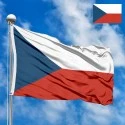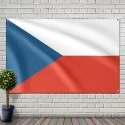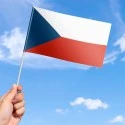The national flag of the Czech Republic, a prominent symbol of statehood and national identity, is a striking design featuring two horizontal stripes of white over red, with a blue isosceles triangle extending from the hoist side to the center of the flag. This tri-color composition, while seemingly simple, is rich in historical significance and symbolic meaning, embodying the past struggles and aspirations for freedom of the Czech people. Its distinct arrangement makes it immediately recognizable among the flags of the world. The flag’s design is a testament to the nation’s journey from its historical roots as the Kingdom of Bohemia to its modern-day independent status.
The dimensions of the Czech flag are precisely defined by law. The flag has a width-to-length ratio of 2 to 3. The two horizontal stripes, white at the top and red at the bottom, are of equal height, each occupying half of the flag’s vertical dimension. The blue isosceles triangle extends from the hoist (left) side of the flag, with its base along the entire height of the hoist and its apex reaching exactly to the horizontal midpoint of the flag, effectively dividing the red and white stripes at that point. While specific official Pantone or RGB values were not initially strictly defined by law, tradition and common usage have led to the adoption of specific shades. The blue is often represented by Pantone 293C (a deep, rich blue), and the red by Pantone 485C (a vibrant, strong red), while the white is a pure, clean white. These colors are not only aesthetically balanced but also carry profound historical and national significance.
The history of the Czech flag is deeply intertwined with the formation of Czechoslovakia after World War I. Prior to 1918, the ancient lands of Bohemia, Moravia, and Czech Silesia, which now form the Czech Republic, were part of the Austro-Hungarian Empire. The traditional colors of Bohemia, dating back to the 12th century, were white and red, derived from the coat of arms of the Kingdom of Bohemia: a silver double-tailed lion rampant on a red field. After the establishment of independent Czechoslovakia in 1918, a simple white-over-red bicolour flag was initially used. However, this design quickly proved problematic for two reasons: firstly, it did not incorporate any symbolism for Slovakia, the other major constituent part of the new state; and secondly, it was almost identical to the national flag of neighboring Poland, leading to confusion. Recognizing the need for a unique and representative flag, a competition was launched. The winning design, adopted on March 30, 1920, incorporated a blue triangle into the existing white and red bicolour. This blue element was chosen to represent Slovakia, as blue was a prominent color in the Slovak traditional heraldry, and also to symbolize Moravia, which historically used a blue shield with a red and white checkered eagle.
The adoption of the flag in 1920 was a significant moment for the newly formed Czechoslovak state, providing it with a distinctive national emblem that symbolized the unity of its diverse constituent parts. Throughout the tumultuous 20th century, the flag endured as a symbol of Czechoslovak statehood. It was suppressed during the Nazi occupation (1939-1945), when a new protectorate flag was imposed, but was immediately reinstated after liberation in 1945. It continued to serve as the national flag during the communist era. Following the peaceful dissolution of Czechoslovakia on January 1, 1993, a constitutional dispute arose regarding the symbols. While a previous agreement stipulated that neither successor state (the Czech Republic or Slovakia) would use the former Czechoslovak symbols, the newly independent Czech Republic decided to retain the flag, citing its historical connection primarily to the Czech lands and the fact that its creation was largely influenced by Czech heraldic experts. This decision, though controversial at the time, solidified the flag’s status as the sole national symbol of the Czech Republic.
The symbolism of the Czech flag is deeply rooted in the nation's history and values. The white color traditionally represents Bohemia, symbolizing purity, honesty, and the peaceful nature of the Czech people. It is also often associated with the bright future of the country. The red color, historically linked to Moravia and the ancient Bohemian lion, signifies courage, valor, and the bloodshed for the freedom and sovereignty of the state. It represents the strength and resilience of the Czech nation. The blue triangle, while initially representing Slovakia within Czechoslovakia, has evolved in its meaning for the independent Czech Republic. It is now widely interpreted to symbolize impartiality, justice, truth, loyalty, and vigilance. Some interpretations also connect the blue to the historical region of Moravia or the blue skies above the country. Together, these colors embody the Pan-Slavic ideals of unity and brotherhood, reflecting the shared heritage with other Slavic nations. The flag, therefore, serves as a powerful reminder of the nation’s journey, its sacrifices for independence, and its enduring commitment to democratic values.
For the inhabitants of the Czech Republic, the flag holds profound significance as a symbol of national identity, pride, and continuity. It is prominently displayed on national holidays, such as Czech Statehood Day (September 28th), the Day of the Establishment of Independent Czechoslovakia (October 28th), and the Day of the Restoration of the Independent Czech State (January 1st). On these occasions, public buildings, private homes, and even monuments are adorned with the flag, expressing collective celebration and remembrance of key historical events. The flag evokes a sense of shared heritage and unity among Czech citizens, bridging regional differences and fostering a common national consciousness. It is a visual representation of their hard-won independence and democratic freedoms. The flag is also a ubiquitous presence in sports events, cultural gatherings, and international forums, where it proudly represents the Czech nation and its achievements on the global stage. It is a source of inspiration and a reminder of the values of self-determination, perseverance, and justice that define the Czech spirit.
Interesting facts about the Czech flag add to its unique story. One of the most intriguing aspects is its complex adoption process: initially a simple bicolour, it underwent a crucial modification to include the blue triangle to better represent the multi-ethnic Czechoslovak state. The designer of the final version adopted in 1920 is widely attributed to Jaroslav Kursa, an archivist and heraldist, who submitted the design to the parliamentary commission responsible for the new state symbols. Another interesting point is the controversy surrounding its retention by the Czech Republic after the 1993 split. Despite a prior agreement not to use former Czechoslovak symbols, the Czech Republic’s parliament voted to keep it, leading to a period of diplomatic tension with Slovakia. This highlights the deep emotional attachment and historical claim the Czechs felt towards this particular design. Furthermore, while the flag’s official dimensions and color placement are fixed, the exact shades of red and blue were not rigorously standardized until later regulations, allowing for slight variations in production throughout history. The flag’s widespread use in various forms, from small commemorative pins to large banners, demonstrates its pervasive presence in Czech daily life and its role as an enduring emblem of national pride.
In the demonstration images, full-size flags are shown with proportions of 2:3, and hand-held flags with proportions of 1:2.







 Waving flag
Waving flag
 Sizes:
Sizes:
 Round flag
Round flag
 Sizes:
Sizes:
 Rectangular flag 2:3
Rectangular flag 2:3
 Sizes:
Sizes: